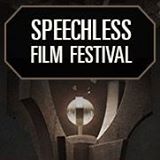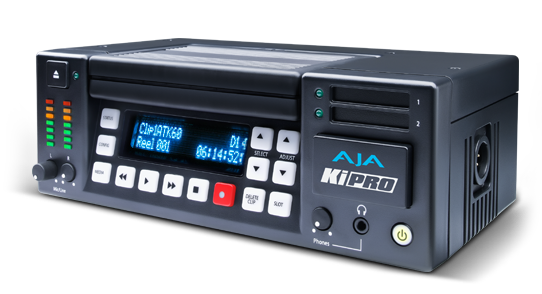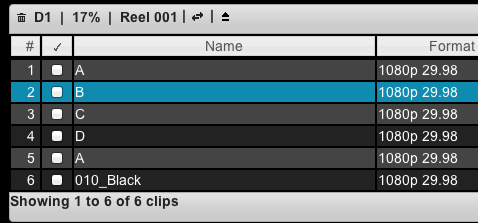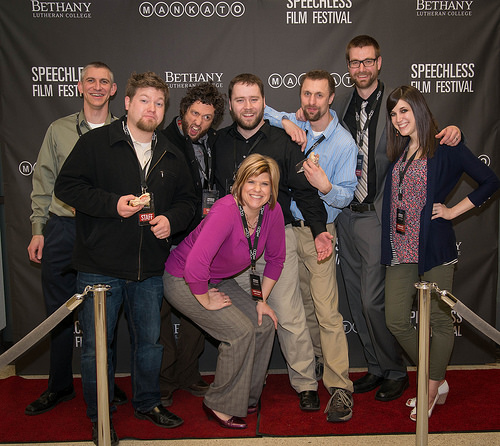
The past two years I have been a part of the team which has been putting on the Speechless Film Festival in Mankato, Minnesota. My main job was to take care of the tech side of things which included everything from renting projectors to finding a playback solution to play films in the three viewing rooms inside the theater.
We just finished up the 2014 Festival and I thought it might be nice to publish some of my ideas and discoveries. Over the past two years I have searched the internet in search of solutions for these problems and I have yet to find exactly the type of information I was looking for.1
First I’ll provide a little background about the venue. Next I’ll talk about our highly detailed list of expectations and requirements. Then I’ll describe the technical setup which we used, the things we liked, some problems we encountered, and some tricks to utilize some nuances to your advantage. Finally, I’ll share some ideas about my ideal setup and some exploration I’ve done in that regard.
The Venue
The venue for the last two years has been the Mankato Place Theater, a small four screen theater locally known as the Mav 4. For a while it was operating as the cheap “dollar theater” but most recently has been sitting unused, except for the occasional political rally and our newly founded Speechless Film Festival.
The largest of the screening rooms holds about 200 people, give or take. The other three are much smaller and about the same size. I would say they each seat 80-100 patrons. The throw distance on the largest screen is about 55 feet, while the other three are around 30 to 40 feet.
The control room still has four large film projectors, though I am doubtful they are in working order. The distance between the two furthest rooms is about 100 feet or so, which easily allows a single person to monitor everything going on at one time.
Expectations and Requirements
As a startup film festival we wanted to make a good impression. While most of us had never been to many (or any) festivals we know how to put on a show or at least come across as professionally and well put together as we could.
- We needed playback to be smooth. From my research it sounded like a lot of festivals would play their playlist of films out of laptops using Quicktime or VLC. While I use both of those systems on a regular basis I don’t trust them for something this important. On top of that, I didn’t like the idea that the computer running the show might have alert popups about pending software updates. That was simply unacceptable.
- Along these same lines, I wanted to avoid graphical user interfaces. Software solutions have playback controls on screen and consumer playback devices like the Apple TV or Roku we not much better. I didn’t want the viewer to see behind the scenes. No GUI, no computer desktops, none of that. I wanted a system that would display black if something went wrong.
- Our parent institution is a small private college and most of us work in the production studio, broadcasting, or Media Arts major, so certainly Final Cut X or Avid could possibly be used for playback, but keeping a computer running in a hot and dusty control room for eight consecutive hours without any issues was not something I was comfortable with. There’s enough variables with the software and the hardware it’s running on, I knew there was a better way.
- Accepted entries were being received as digital files either as Quicktime or MPEG4 format. We asked that everything submitted be encoded as h.264 movie files with bitrates between 10 and 20 Mbps. Ideally I would just be able to play these back, but I knew I could batch convert them if needed.
- The festival schedule was two days long. The short films were separated into sub one hour blocks. A few blocks were repeated while others only played once.2
- Each movie was it’s own file and I wanted to be able to just setup playlists for the showcase blocks. We thought about combining each block into a single movie file, but that was arguably more work than we needed to do and we didn’t have the time we wanted to make sure that happened without error. (If something went wrong with a movie block, we’d be out the whole block, rather than just one film.)
- We weren’t sure about our projectors, but we knew they would most certainly have HDMI in and we were planning to use that, though we were exploring options which might allow for HDSDI as well.
- The theater sound system we would hook into had RCA connectors for audio so whatever played out the files would need a dedicated audio out. (Not a huge problem, most things do have this, but just mentioning it here for posterity.)
Now, our studio has a 30 foot broadcasting trailer and we talked about the possibility of running everything out through that, but not only was it overkill, there wasn’t really any good way for us to get the trailer to the theater. We also have a mobile flypack and while that might be helpful, it didn’t solve the problem about what was playing the movies.
Our Solution

After a fair amount of research, I decided on using a Ki Pro Player from AJA. Designed as a system for capturing video into a format that is immediately ready to edit, the Ki Pro also can be used as a decent playback system. The unit retails for $3995 and we were going to need three of them, but we have good connections and were able to rent them from our contact for a decent daily rate.
The Ki Pro player had a number of key features for us.
- AJA makes solid equipment. We knew this wasn’t going to fail on us. We also knew that if something went horribly wrong the system would simply output a black screen.
- The Ki Pro Player has an ethernet port which allows you to control the system from any computer that has a web browser and is connected to the same network. This also meant we could control multiple systems from one central location.
- The Ki Pro allows you to create playlists.
- The Ki Pro has a variety of outputs on the back, HDSDI, HDMI, Component, Composite, you name it.
- The media is all stored on a specialized drive that can be connected to a computer using a firewire 800 port.
- All of these features made the Ki Pro Player a good choice, but there were a few downsides. None of these are deal breakers, and some aren’t even really “problems” but they are things I noticed and thought fit to mention here.
- The player was created to work specifically with Apple ProRes 422 video files. This is an uncompressed video format which roughly translates into extremely large files.3 The ratio is approximately 1GB per minute of video. This also meant we needed to convert all of our files.
- The players we rented had 250GB or 500GB hard drives. They are special drives so you can’t use your own. The 250GB drives were not large enough for all the movies, which meant we had to swap them out.
- Videos on the device are sorted by creation date by default. This makes a lot of sense for capturing video, but made it a bit more difficult for us when hunting for files. Ultimately, I ended up using the terminal and touched the creation date for everything so it was all the same, then it sorted by file name.
- The web interface is really nice, but it sometimes feels a bit clunky or slow.
- The playlist feature wasn’t quite as solid as we originally anticipated. While you can put the same clip into a playlist multiple times, it didn’t quite work as you would expect. I managed to utilize this to our advantage this year, but it caused some annoyance the first time around.
The Problem with Playlists
We wanted to put a short 3 second clip of black in between each film in the block to help the audience refocus. (Perhaps catch their breath or dry their eyes, sometimes you have some conflicting films go back to back.)
We also had a 10 minute loop of ads and preview to show in each theater before the films started. We wanted this to play right after the last film finished while the audience filed out and the next group meandered in.
You could ad the same file to a playlist multiple times, but it didn’t work like iTunes or VLC. I’m pretty sure it’s a bug in the Ki Pro Player, but it’s actually a rather helpful bug if you use it to your advantage. Here’s a sample playlist:

You would expect that the player would play the films like this: A, B, C, D, A, 010_Black, and then be done.
It doesn’t. It actually plays A, B, C, D, A, B, C, D, A, B, C, D, A, etc.
When it plays the second instance of a file, it actually “jumps” back to the first instance of the file and continues playing the playlist from there.
The first year we did this, we put a segment of black between each film and immediately discovered that we were just looping the second film over and over again. We took out the black and the problem was solved.
This year, I was able to do some more testing and discovered that if the second instance of the file is the last file in the playlist… at which point it plays it a second time and then stops playing.
So we got smart, and simply made ten copies of our black clip, gave it 10 different names, and never used the same one twice in the same playlist. Problem solved.
I also discovered that if I put three copies of my “ad and preview” loop at the end of a playlist, (along with another clip of black at the end) that the ad loop would go indefinitely. This meant that you could tell the playlist to start at the appropriate time and didn’t have to worry about anything until you told the next playlist to play at the appropriate time.
The Ki Pro Players actually turned out to be a really good solution for us. We made sure we had ample time to test the players and make sure all the footage worked, and things went really smoothly.
The Future
For two years in a row, this method is solid and is probably one that we will continue to use in the future if we can. The biggest drawback I think is the need for ProRes files and the fairly small hard drive sizes on the players. AJA apparently offers some 750GB drives, but I do not know if they will be available for us to rent or not.
As I continued to research options this spring, I came across a really intriguing concept. What about Digital Signage?
The promise of digital signage software is extremely enticing. Many of the solutions can playback H.264 video, some of them even capable of 20Mbps bitrates. All of them have playlist capabilities, and scheduling options. Many can be controlled from a central location, and some will even update their files from a networked server or NAS.
Imagine this: all your files live on a central PC connected to this network. You setup a playlist for each movie you want to show. When these playlists are not active, the signage system will automatically play through the loop of ads and previews. Days before the festival begins you can setup the schedule so that the movies will all begin automatically at the appropriate time. When it’s showtime you’re only responsibility is to turn everything on and the festival will literally run itself.
I got a couple demo units from a company to test out this as a possibility, but the reliability just wasn’t quite there yet.
The current downsides to this utopian solution are that digital software solutions are still fairly expensive. There are a few options which only cost a few hundred dollars, much cheaper than a $4K Ki Pro, but that doesn’t mean they are cheap. The other downside is that they are typically clunky, the user interfaces are hard to navigate, and they don’t seem to be as reliable as I would like them to be.
Despite these current limitations, I think that there is a lot of potential down this road and I will continue to explore new options as they appear.

1. If anyone knows of some good user groups or forums for this type of discussion, let me know. ↩
2. Our festival encouraged a lot of short films and we had a large number of movies that were only 10 minutes long or shorter. ↩
3. Compared to H.264 files. ↩